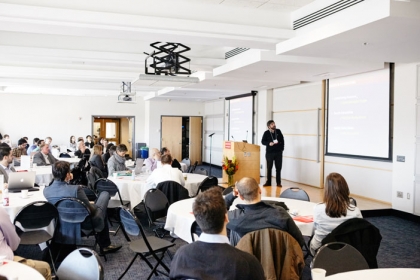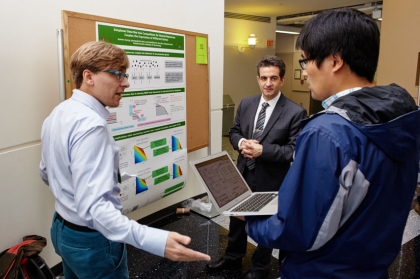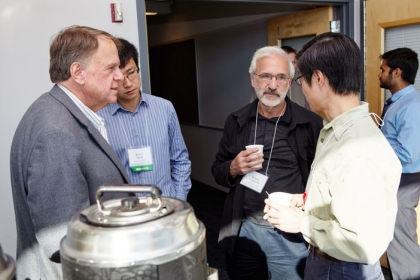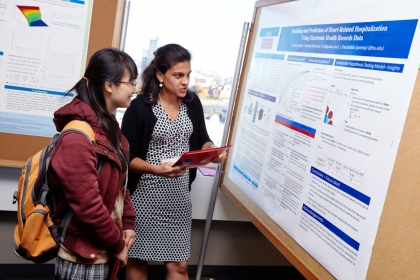CISE Hosts International Symposium on Control of Network Systems
Attendees Celebrate New IEEE Journal Edited by ENG’s Paschalidis
By Mark Dwortzan

Professor Christos Cassandras (ECE, SE) describing a strategy to maximize battery lifetimes in wireless sensor networks at SCONES, held October 27-28 in the Photonics Center Colloquium Room (Photos by Dave Green)
Microbes are all around us—even inside us—and that’s a good thing. Left alone, these tiny organisms have a huge impact on everything from human health to wastewater treatment. But with a little engineering, they could do even more. In certain environments, their metabolic processes could be exploited to make biofuels, vaccines and other useful products and services. To tap their potential,Associate Professor Daniel Segrè (Biology, BME, Bioinformatics) and collaborators have developed mathematical models to predict the metabolic interactions that occur among different microbial species under varying environmental conditions, and to design new microbial networks with desired properties.
Segrè presented his research at the first Symposium on the Control of Network Systems (SCONES), held on October 27-28 in the Photonics Center Colloquium Room.
Sponsored by the IEEE Control Systems Societyand the Center for Information and Systems Engineering at Boston University, SCONES celebrated the inaugural March 2014 issue of theIEEE Transactions on Control of Network Systems (TCNS), a new IEEE Transactions journal edited by Professor Yannis Paschalidis (ECE, BME, SE) focused on problems related to the control, design, study, engineering, optimization and emerging behavior of network systems.
“We live in a world that is extremely interconnected,” said Paschalidis, the journal’s editor-in-chief. “This is also true of systems, biological or manmade, that support our modern way of life. Networks, which both connect system components and influence how they function as a whole, are increasingly the focus of leading edge research, and this is the impetus forTCNS and SCONES.”

TCNS Editor-in-Chief Professor Yannis Paschalidis (ECE, SE, BME) (center) with MIT PhD student Andras Gyorgy (left) and another SCONES participant (right) during a poster session.
One author of each paper in the inaugural issue presented at the symposium, along with talks and posters from several other researchers in the field. Representing major research institutions from around the world, SCONES presenters explored the analysis, control and optimization of electric power, computer, communication, transportation, biological, cyber-physical, social and economic networks. As if bringing the TCNS journal to life, the 23 featured speakers illustrated complex concepts with a flurry of equations, algorithms, graphs and diagrams.
“TCNS aspires to become the premiere destination for mathematically rigorous work in network systems,” said Magnus Egerstedt, an ECE Professor at Georgia Tech and the TCNS deputy editor-in-chief—and the SCONES presenters lived up to that promise.
In addition to Segrè, two other Boston University researchers shared highlights of papers they co-authored in the inaugural issue of TCNS on resource allocation and routing, the selection of optimal path by which to transmit information across the nodes of a network.
Professor Lev Levitin (ECE, SE) presented an alternative to wormhole routing, a widely used routing technique that’s prone to deadlock—multiple messages getting blocked by one another in a vicious cycle—under heavy computer network traffic. Levitin described a series of new, high-performance algorithms that he, Professor Mark Karpovsky (ECE) and ECE Visiting Researcher Mehmet Mustafa developed to break such cycles and prevent deadlock formation during routing and thus preserve network connectivity.

Professor Michael Caramanis (ME, SE) (second from right), who chaired the symposium’s first session on control and optimization of electric power networks, with University of Maryland Professor John Baras (ECE) (left), BU Systems Engineering PhD student Bowen Zhang (second from left) and California Institute of Technology Professor Steven Low (ECE) (right) during a break.
Professor Christos Cassandras (ECE, SE) presented an optimal control strategy that he, Tao Wang (SE, PhD’13) and Sepideh Pourazarm (SE, PhD candidate) devised to maximize the lifetime of sensor batteries deployed at each node of a wireless sensor network for surveillance, environmental monitoring or other applications where human intervention may be inconvenient or costly.
“Because every node has limited energy, you have to worry about the battery dying and the network ceasing to function,” said Cassandras, “so you need to focus on battery lifetime.”
Modeling each battery as a dynamic system in which energy does not dissipate in a linear fashion, the strategy uses an algorithm to determine the routing scheme that will minimize that energy loss.
The symposium, which was well-attended and featured many fruitful exchanges between speakers and attendees, signified how well the TCNS journal has been received by the international research community, Paschalidis observed.
“In the first three TCNS issues published in 2014, we have seen papers covering many types of network systems, from networked control and multi-agent systems, to communication, transportation, electric power, biological and social networks,” he noted. “SCONES is playing a key role in coalescing a community of researchers around the journal.”

